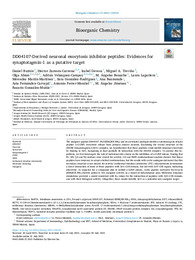Por favor, use este identificador para citar o enlazar este ítem:
https://hdl.handle.net/11000/35276Registro completo de metadatos
| Campo DC | Valor | Lengua/Idioma |
|---|---|---|
| dc.contributor.author | Butron, Daniel | - |
| dc.contributor.author | Zamora-Carreras, Héctor | - |
| dc.contributor.author | Devesa Giner, Isabel | - |
| dc.contributor.author | Treviño, Miguel A. | - |
| dc.contributor.author | Abián, Olga | - |
| dc.contributor.other | Departamentos de la UMH::Bioquímica y Biología Molecular | es_ES |
| dc.date.accessioned | 2025-01-24T17:20:50Z | - |
| dc.date.available | 2025-01-24T17:20:50Z | - |
| dc.date.created | 2021-07 | - |
| dc.identifier.citation | Bioorganic Chemistry Volume 115, October 2021, 105231 | es_ES |
| dc.identifier.issn | 1090-2120 | - |
| dc.identifier.issn | 0045-2068 | - |
| dc.identifier.uri | https://hdl.handle.net/11000/35276 | - |
| dc.description.abstract | The analgesic peptide DD04107 (Pal-EEMQRR-NH2) and its acetylated analogue inhibit α-calcitonin gene-related peptide (α-CGRP) exocytotic release from primary sensory neurons. Examining the crystal structure of the SNARE-Synaptotagmin-1(Syt1) complex, we hypothesized that these peptides could inhibit neuronal exocytosis by binding to Syt1, hampering at least partially its interaction with the SNARE complex. To address this hy pothesis, we first interrogate the role of individual side-chains on the inhibition of α-CGRP release, finding that E1, M3, Q4 and R6 residues were crucial for activity. CD and NMR conformational analysis showed that linear peptides have tendency to adopt α-helical conformations, but the results with cyclic analogues indicated that this secondary structure is not needed for activity. Isothermal titration calorimetry (ITC) measurements demonstrate a direct interaction of some of these peptides with Syt1-C2B domain, but not with Syt7-C2B region, indicating selectivity. As expected for a compound able to inhibit α-CGRP release, cyclic peptide derivative Pal-E-cyclo [EMQK]R-NH2 showed potent in vivo analgesic activity, in a model of inflammatory pain. Molecular dynamics simulations provided a model consistent with KD values for the interaction of peptides with Syt1-C2B domain, and with their biological activity. Altogether, these results identify Syt1 as a potential new analgesic target | es_ES |
| dc.format | application/pdf | es_ES |
| dc.format.extent | 15 | es_ES |
| dc.language.iso | eng | es_ES |
| dc.publisher | Elsevier | es_ES |
| dc.rights | info:eu-repo/semantics/openAccess | es_ES |
| dc.rights | Attribution-NonCommercial-NoDerivatives 4.0 Internacional | * |
| dc.rights.uri | http://creativecommons.org/licenses/by-nc-nd/4.0/ | * |
| dc.subject | DD04107 | es_ES |
| dc.subject | Ala-scan | es_ES |
| dc.subject | Exocytosis | es_ES |
| dc.subject | Synaptotagmin-1 | es_ES |
| dc.subject | CGRP | es_ES |
| dc.subject | NMR | es_ES |
| dc.subject | Isothermal titration calorimetry | es_ES |
| dc.subject | Molecular modeling | es_ES |
| dc.subject | Analgesia | es_ES |
| dc.subject.other | CDU::5 - Ciencias puras y naturales::57 - Biología::577 - Bioquímica. Biología molecular. Biofísica | es_ES |
| dc.title | DD04107-Derived neuronal exocytosis inhibitor peptides: Evidences for synaptotagmin-1 as a putative target | es_ES |
| dc.type | info:eu-repo/semantics/article | es_ES |
| dc.relation.publisherversion | https://doi.org/10.1016/j.bioorg.2021.105231 | es_ES |

Ver/Abrir:
2021_01_Butron D_BioChem_2021.pdf
694,62 kB
Adobe PDF
Compartir:
 La licencia se describe como: Atribución-NonComercial-NoDerivada 4.0 Internacional.
La licencia se describe como: Atribución-NonComercial-NoDerivada 4.0 Internacional.
.png)